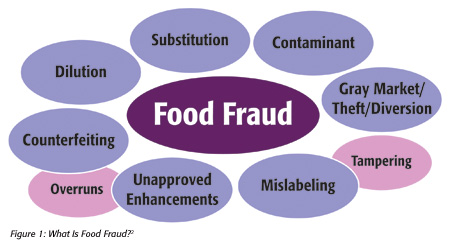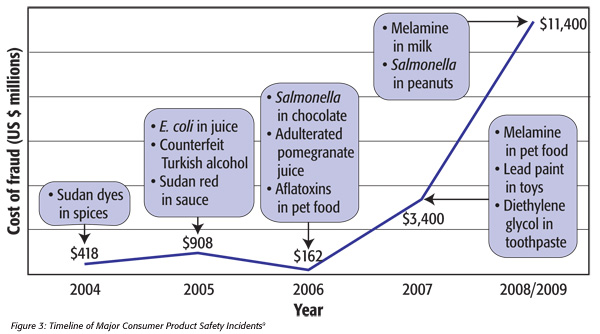From horse meat to seafood, food fraud is a growing problem worldwide. According to the World Customs Organization, food fraud is costing $49 billion annually.[1]
As the global food supply chain widens, the challenges of safeguarding our food supply have increased and more advanced fraud detection procedures are needed. This article takes a closer look at food fraud and its history, and discusses current trends, solutions and what’s in store for the future.
The Global Food Fraud Situation
Increasingly globalized food supply chains and the economic motivation to provide cheaper food products have contributed to the food fraud issue, with recent news articles about horse meat in beef products drawing worldwide attention to the growing problem.
“What we’re seeing today is an increasingly complex and fragmented food supply chain,” according to NSF International’s Global Food Safety Division Managing Director David Edwards. “Due to both its global nature and the fact that most food today no longer follows a straight line from source to fork, it is more like a supply ‘network,’ and tracing an ingredient back to its source has become challenging due to this increasing network of handlers, suppliers and middlemen globally.”
In addition to the globalization of the supply network making detection harder and adulteration easier, other trends influencing the rise in food fraud include cost cutting as the food industry is under constant pressure to keep prices down, according to Edwards, and that leads to the temptation to substitute, sometimes at the cost of safety and certainly at the cost of provenance and integrity.
Since there is a distinct possibility of harm from ingesting adulterated food, economically motivated adulteration (EMA), or more specifically food fraud, has been identified as a public health threat through research undertaken at Michigan State University (MSU)’s Anti-Counterfeiting and Product Protection Program.[2, 3]
Types of Food Fraud
 John Spink and Douglas Moyer, authors of the MSU study, define food fraud as “a collective term used to encompass the deliberate and intentional substitution, addition, tampering, or misrepresentation of food, food ingredients or food packaging; or false or misleading statements made about a product, for economic gain” (Figure 1[2]). In the study, Spink and Moyer identify seven distinct kinds of food fraud:
John Spink and Douglas Moyer, authors of the MSU study, define food fraud as “a collective term used to encompass the deliberate and intentional substitution, addition, tampering, or misrepresentation of food, food ingredients or food packaging; or false or misleading statements made about a product, for economic gain” (Figure 1[2]). In the study, Spink and Moyer identify seven distinct kinds of food fraud:
• Adulteration: A component of the finished product is fraudulent.
• Tampering: Legitimate product and packaging are used in a fraudulent way.
• Overrun: Legitimate product is made in excess of production agreements.
• Theft: Legitimate product is stolen and passed off as legitimately procured.
• Diversion: The sale or distribution of legitimate products outside of intended markets.
• Simulation: Illegitimate product is designed to look like, but not exactly copy, the legitimate product.
• Counterfeit: All aspects of the fraudulent product and packaging are fully replicated.[2]
Shaun Kennedy, who is with the National Center for Food Protection and Defense, claims, “About 10 percent of the food you buy in the grocery shelf is probably adulterated,”[4] and this supports data from the International Chamber of Commerce that claim 7 percent of our food supply contains fraudulent ingredients.[5]
Economically Motivated Adulteration
Food fraud includes economically motivated adulteration, called EMA by some experts. The U.S. Food and Drug Administration (FDA) defines EMA as the “fraudulent, intentional substitution or addition of a substance in a product for the purpose of increasing the apparent value of the product or reducing the cost of its production.”[6]
EMA is a food defense issue because, by definition, it is an intentional act. More significantly, it is a criminal act, because it is perpetrated by individuals who defraud the public for economic gain.
A 2011 U.S. Government Accountability Office (GAO) report entitled Food and Drug Administration (FDA): Better Coordination Could Enhance Efforts to Address Economic Adulteration and Protect the Public Health identified supply chain complexity as a challenge in the detection and prevention of economic adulteration.[7] The report highlights two situations posing significant public health risks: the use of melamine, an industrial chemical, and heparin, a blood thinner, where ingredients were evidently added to products to increase the apparent value or reduce their production costs (e.g., economic adulteration).
 In the GAO report, the FDA commissioner underscores these growing challenges and emphasizes how economic adulteration remains a public health threat. The report also emphasizes how another public health crisis like heparin or melamine contamination is inevitable unless changes are made to ensure the safety and quality of food and a more robust, collaborative and proactive, not reactive, fraud detection system is planned and implemented. Figure 2[8] identifies the 15 most problematic ingredients for EMA.
In the GAO report, the FDA commissioner underscores these growing challenges and emphasizes how economic adulteration remains a public health threat. The report also emphasizes how another public health crisis like heparin or melamine contamination is inevitable unless changes are made to ensure the safety and quality of food and a more robust, collaborative and proactive, not reactive, fraud detection system is planned and implemented. Figure 2[8] identifies the 15 most problematic ingredients for EMA.
Deliberate contamination for economic gain is not new. Tampering with the food chain likely has occurred, either undetected or unreported, over many years because criminals worldwide have identified opportunities for significant financial gain by exploiting an intricate, largely hidden system of food supply and distribution networks.
History of Food Fraud
 Food fraud originated as a way to extend a food’s primary ingredients for added profit. As early as the 17th century, governments started to introduce food purity laws to address abuses that included watered-down milk and the use of chalk as filler in bread (Figure 3[9]).[10] These practices and others soon raised concerns about food safety.
Food fraud originated as a way to extend a food’s primary ingredients for added profit. As early as the 17th century, governments started to introduce food purity laws to address abuses that included watered-down milk and the use of chalk as filler in bread (Figure 3[9]).[10] These practices and others soon raised concerns about food safety.
As markets have grown from local to global, supply chains have become more complex, and this has opened the door to food fraud on a larger scale. Today, a growing number of leading manufacturers and retailers have endured the consequences either through sourcing and supply challenges, a drop in market share or increasing consumer distrust. Consumers, too, are demanding increased legislative protections, and food companies are responding to protect their reputations. According to an Oxford Metrica report, Reputation & Value: The Case of Corporate Catastrophes, 85 percent of the firms surveyed considered brands to be their most important asset.[11] A strong corporate reputation will more likely generate sales, customer loyalty and sustained market share. The key take-away item from the report is that it is vital for businesses to be aware of how stakeholders perceive their brand and reputation, and to be prepared for specific erosion or damage to the key drivers of brand value. It also is vital that businesses identify the key drivers of brand values in their own industry sector so managers are able to recognize and assess the relative threat to reputation posed by crises that may occur.
Revisiting the Horse Meat Scandal
Throwing the issue of food fraud into public consciousness, the horse meat scandal received widespread media coverage earlier this year, including this summary in New Food Magazine[10] of the growing epidemic of food fraud:
“In this instance, the meat product eventually substituted for beef travelled back and forth between several European countries over time, across a network that made it difficult if not impossible to track and trace. Complex supply networks by their very nature favor crime and hinder detection.
“French authorities ultimately identified a French meat wholesaler as the prime suspect in Europe’s horse meat controversy. The government’s consumer affairs minister determined that fraudulent meat sales had stretched over several months, across 13 countries and 28 companies. Meanwhile, Britain’s food regulator reported that six horse carcasses tested positive for an equine painkiller that may have entered the human food chain in France. Almost simultaneously, arrests were made on suspicion of fraud at two meat plants in Wales.”
The Europe-wide scandal surrounding the substitution of cheaper horse meat in what had been labeled beef products caught the most attention from consumers, regulators and investigators this year. Yet this scandal represents only a small segment of a much larger crisis that encompasses the bulking up, watering down, substitution, mislabeling and other misrepresentation of the contents of the food we eat. In terms of food fraud, this could be an indication of what is occurring as the economic crisis persists.
According to a June article in The New York Times,[12] investigators uncovered thousands of frauds, raising questions about regulatory oversight as criminals offer bargain-hunting shoppers cheap versions of everyday products. As the horse meat scandal showed, even legitimate companies can be overtaken by food fraud.
U.S. Seafood Industry
The U.S. seafood industry also has suffered from its own version of a bait-and-switch. An article in The Boston Globe reported that fish served in area restaurants was incorrectly identified about half the time, sometimes deliberately.[13] In many cases, less desirable and cheaper species took the place of fresh, local varieties.[14]
Regulation of the U.S. fishing industry is handled by four agencies: the U.S. Department of Agriculture for marketing, the U.S. Environmental Protection Agency for sport and recreation fishing, FDA for fish safety and the National Oceanic and Atmospheric Administration for ocean fisheries. Efforts are underway to tighten regulation, including the introduction of the Safety and Fraud Enforcement for Seafood Act, which is designed to track fish from the vessel to the consumer to tackle fraud that cheats fishermen and consumers and poses health risks to those with a compromised immune system.[15]
According to the article, Massachusetts lawmakers are taking steps to combat seafood fraud with a bill introduced earlier this year that would fine supermarkets and restaurants that mislabel seafood.13 Businesses caught substituting fish for varieties such as Atlantic cod, Atlantic halibut, red snapper and gray sole could face fines and have their operation licenses suspended or revoked. Public interest groups from Florida to California reported similar instances of mislabeling, including fish presented as “local” that in fact came from distant waters.
Who’s Responsible?
Everyone has a role in addressing the threat of food fraud. Suppliers play a crucial role in deterrence and detection of economic adulteration. In addition to implementing strategies similar to manufacturers’, suppliers also can consider ways to facilitate appropriate testing procedures, provide increased transparency and timely information and partner with manufacturers in their downstream efforts to reduce fraud.[9]
For the retailer, it’s very important to partner with reputable suppliers and manufacturers that utilize the highest standards in terms of deterrence and detection and to monitor their activities on an ongoing basis. Retailers should confirm their suppliers are providing genuine and safe products that have not been counterfeited.[9] They also can work with supply chain partners to minimize the impact when incidents occur through timely communication and an efficient product recall process, which now is more important than ever.
Fifty years ago, the average grocery store stocked about 200 items, of which 70 percent were grown, produced or processed within 100 miles of where they were eventually purchased. Today, the average supermarket stocks close to 39,000 food items. By some estimates, the food Americans eat has traveled, on average, 1,500 miles before it is consumed.[16]
For standards in food and product safety to rise to the next level, consumers need to demand higher food safety standards.[9] Manufacturers can support this effort by helping consumers identify issues, giving them the resource to identify fraudulent products so they know what to look for to avoid these products.
The role of the government is to ensure certain rights and safeguards are in place and to enforce them.[9] Governments can support legitimate businesses through the protection of property rights and by reducing the number of illegal businesses. Additionally, they can leverage their customs and border protection agencies to prevent illegal and potentially unsafe products from entering their countries.
Because of its complexity and worldwide reach, reining in food fraud requires a collaborative effort between industry and government agencies, says Edwards. It will also demand a dedicated effort across the food supply chain, from producers and distributors to consumers. For additional insight about combating this issue, see “Challenges and Solutions in Combating Global Food Fraud.”
Potential Solutions
In addition to identifying the roles manufacturers, suppliers, consumers and the government play in reducing fraudulent activity, the Grocery Manufacturers Association report9 also calls out three fundamental guidelines to improve how the industry detects and deters fraud:
• Become more proactive in addressing economic adulteration: Many companies have already implemented ways to counter global fraud threats, but more needs to be done.
• Find new ways to share information and promote collaboration: Identify a formal way to collaborate with industry, government, academia and nongovernmental organizations and increase global engagement.
• Engage government as a facilitator: Governments can establish global standards and share intelligence on emerging threats, which is crucial to addressing threats that are further magnified by globalization, more integrated supply chains and a global consumer base with similar requirements.
A global public health and safety organization, NSF International has brought together an expert group of food practitioners, regulators, scientists and academics to help further define the food fraud problem and provide guidelines and best practices to help safeguard against it.
“Increasing engagement and collaboration are essential to protecting our global food supply,” says Tom Chestnut, vice president, NSF International’s Global Food Division.
Safety Standards
Another possible solution is certification to global food safety standards. Due to complex challenges in today’s food supply chain, many of the world’s largest food retailers are now mandating supplier certification to Global Food Safety Initiative (GFSI) schemes.
GFSI was established to ensure confidence in the delivery of safer food to consumers while continuing to improve food safety throughout the supply chain. These global standards address food, packaging, storage and distribution for producers, manufacturers and distributors. With exceptional technical expertise, calibrated auditors and capacity for a timely path to certification, NSF International offers certification to GFSI-benchmarked standards as part of its comprehensive range of supply chain assurance services.
Food Safety Modernization Act
According to the GAO report, some food industry members also stated that the passage of the Food Safety Modernization Act (FSMA) provides additional opportunities for FDA and industry to address economic adulteration. For example, the law provides a science- and risk-based approach for companies to verify their ingredient suppliers, including multiple ways to assure the public and FDA that industry has processes in place to detect economic adulteration.[7] FSMA also requires some facilities to identify reasonably foreseeable hazards and to prepare written control plans that illustrate reasonable approaches to looking for intentional adulteration.
By requiring a risk-based approach to identifying and implementing preventive controls, FSMA places new and more extensive requirements on food manufacturers, processors, growers and importers.[17] FSMA focuses primarily on the following to minimize or prevent food safety hazards:
• Produce safety
• Imported food safety
• Mandated inspections on a risk-based schedule
• Third-party laboratory testing
• Farm-to-table responsibility
• Ability to require third-party certification for high-risk operations
Another important component of the legislation provides for FDA recognition of accredited third-party audit and certification programs for imported foods, a category that has grown steadily over the years.
Currently, FDA is holding meetings and receiving comments on how to best implement the new law and promulgate effective regulations. To date, two of the five proposed FSMA rules related to produce and processing have been published. Additional updates can be found at www.fda.gov/fsma.
Food Defense Plans
Implementing a strong food defense plan is another way for food processors, packagers and distributors to limit intentional and malicious food tampering. Food defense plans are also increasingly required for food safety certification and vendor qualification, as well as by FSMA, which requires facilities to identify and evaluate food hazards, including those introduced intentionally, and implement and document preventive controls to provide assurance that food is not adulterated.
Food companies at all levels of the supply chain can assess their level of food defense preparedness through a food defense audit by an independent third party.
Continuing the Search for Solutions
This article discussed some incidents of food fraud and the means to help prevent it given the new challenges of the global supply chain and economic hardships. The food industry and regulators are coming together and continuing to implement solutions.
As this article points out, preventing food fraud demands the involvement of every segment of the industry as well as consumers and the government. What’s needed now? More reliable data, improved data analysis, new tools and technologies for data sharing and a greater understanding of the underlying scientific, economic and cultural issues that enable food fraud. A greater collaboration between government and industry will certainly help.
 Patrick Pimentel, M.Sc. Ed. PH serves as technical services manager for NSF International’s Global Food Division and has worked at NSF International for 14 years. His food safety experience spans across the food supply chain from retail and agriculture to technical services. Pimentel is a certified professional food manager. NSF International is a global public health organization that writes standards, conducts audits and tests and certifies products for the food, water, consumer goods and health sciences industries.
Patrick Pimentel, M.Sc. Ed. PH serves as technical services manager for NSF International’s Global Food Division and has worked at NSF International for 14 years. His food safety experience spans across the food supply chain from retail and agriculture to technical services. Pimentel is a certified professional food manager. NSF International is a global public health organization that writes standards, conducts audits and tests and certifies products for the food, water, consumer goods and health sciences industries.
References
1. www.americanbar.org/content/dam/aba/events/tort_trial_insurance_practice/2013/08/annual_2013/ABA_TIPS_Annual_Meeting_2013_%20Brochure.authcheckdam.pdf.
2. foodfraud.msu.edu/wp-content/uploads/2013/07/MSU-FFI-Spink-IAFP-2013-S33-v4-for-attachment-for-IAFP-post.pdf.
3. Spink, J. 2013. Economically motivated adulteration: Another dimension of the “expanding umbrella of food defense.” Food Safety Magazine 19(5):46–53.
4. www1.umn.edu/news/features/2013/UR_CONTENT_434622.html.
5. ICC Counterfeiting Intelligence Bureau. 1997. Countering counterfeiting: A guide to protecting and enforcing intellectual property rights. United Kingdom.
6. www.manufacturing.net/articles/2012/09/economically-motivated-adulteration-is-your-brand-at-risk.
7. www.gao.gov/assets/590/585862.html.
8. nabc.cals.cornell.edu/Publications/Reports/nabc_23/23_5_3_Moore.pdf.
9. www.gmaonline.org/downloads/research-and-reports/consumerproductfraud.pdf.
10. www.newfoodmagazine.com/wp-content/uploads/NSF-Whitepaper.pdf.
11. Knight, R.F. and D.J. Pretty. 2001. Reputation and value: The case of corporate catastrophes. Oxford Metrica.
12. www.nytimes.com/2013/06/27/business/food-fraud-more-widespread-than-suspected.html?pagewanted=all&_r=0.
13. www.bostonglobe.com/business/2013/02/21/fish-mislabeling-common-throughout/kHVFNwzerS9Ws84SuvZC1H/story.html.
14. Samiere, W. 2013. Authentication in seafood. Food Safety Magazine 19(5):54–57.
15. www.foodsafetynews.com/2013/03/rep-market-introduces-safe-seafood-act-to-combat-fish-fraud.
16. www.globalization101.org/food-borne-illness.
17. www.foodquality.com/details/article/5082501/Preparing_for_FSMA_Compliance_Are_You_Ready.html?tzcheck=1.



